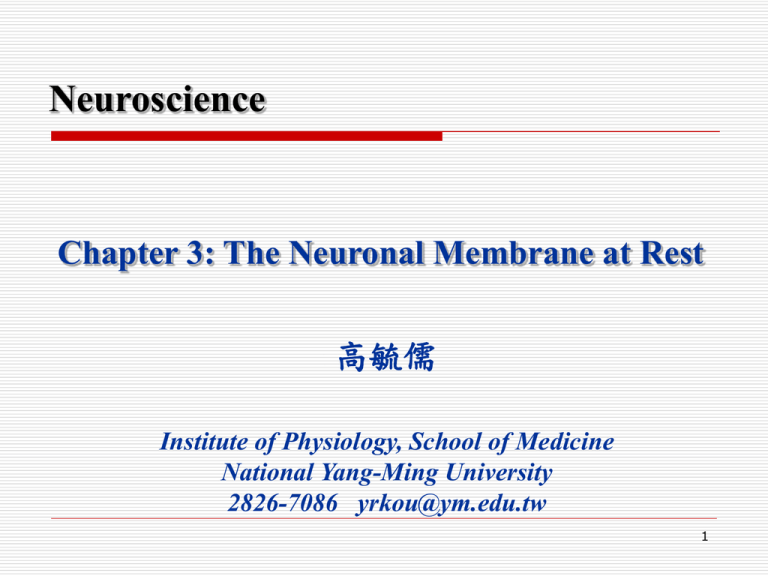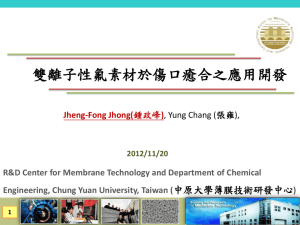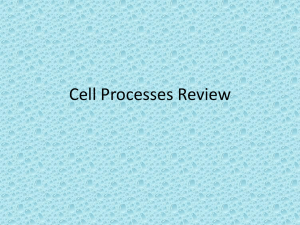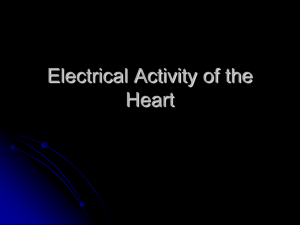Introduction
advertisement

Neuroscience Chapter 3: The Neuronal Membrane at Rest 高毓儒 Institute of Physiology, School of Medicine National Yang-Ming University 2826-7086 yrkou@ym.edu.tw 1 Outline Introduction The Cast of Chemicals The Movement of Ions The Ionic Basis of the Resting Membrane Potential Review 2 Introduction What we are? 3 Introduction Example-A Simple Reflex (BF3.1) 4 Introduction A Simplified Structure 5 Introduction Structure and Function Cognition and Behavior The Nervous System The Neuron Collection, Distribution and Integration Excitation 6 Introduction A Simplified Function Encoding by Frequency and Pattern Conduction Action Potential Resting Membrane Potential 7 Analogy Introduction Light or Heat Conduction Electricity Differences Generator 8 The Beauty Important Elements Ions Bilayer membrane Differential permeability to ions Channels and pumps Differential responses 9 The Cast of Chemicals Water and Ions Cations and anions Monovalient and divalent + + 2+ Na , K , Ca , Cl 10 The Cast of Chemicals Phospholipid Membrane Phospholipid bilayer Hydrophilic and hydrophobic 11 The Cast of Chemicals Channel Protein Ion channels and ion pumps 12 The Cast of Chemicals Protein Amino acids and polypeptides 13 The Movement of Ions Diffusion Concentration gradient 14 The Movement of Ions Electrical Current Ohm’s law: I = gV g: conductance I: currect V: potential 15 The Movement of Ions Electrical Current g=0 g>0 16 Resting Membrane Potential Measurement 17 Resting Membrane Potential Equilibrium Potential 18 Resting Membrane Potential Equilibrium Potential Minuscule changes in ionic concentration 100 mM 99.99999 mM Large changes in membrane potential 0 mV 80 mV 19 Resting Membrane Potential Equilibrium Potential The difference occurs only at the inside and outside surface. Vm – Eion = ionic driving force 20 Resting Membrane Potential Equilibrium Potential + Another example: Na 21 Resting Membrane Potential Equilibrium Potential The Nernst equation 22 Resting Membrane Potential Ionic Distributions 23 Resting Membrane Potential + Ionic Distributions + Role of Na -K pump – an electrogenic pump 24 Resting Membrane Potential Ionic Distributions 2+ Role of Ca pump 25 Resting Membrane Potential + Ionic Permeabilities + Na and K - equilibrium potential + + PNa < 40 X PK The Goldman equation 26 Resting Membrane Potential Potassium Channels Structure 27 Resting Membrane Potential Potassium Channels + Effect of external K concentration Deporlarization 28 Resting Membrane Potential Potassium Channels + Protection by blood-brain barrier Protection by astrocytes via spatial buffering 29 Resting Membrane Potential Sodium Channels + Effect of external Na concentration 30 Review Resting Membrane Potential What two functions do proteins in the neuronal membrane perform to establish and maintain the resting membrane potential? On which side of the neuronal membrane are Na+ ions more abundant? + When the membrane is at the K equilibrium potential, in which direction (in or out) is there + a net movement of K ? 31 Resting Membrane Potential Review There is a much greater K +concentration inside the cell than outside. Why, then , is the resting membrane potential negative? When the brain is deprived of oxygen, the mitochondia within neurons cease producing ATP. What effect would this have on the resting membrane potential? 32 Neuroscience Chapter 4: The Action Potential 高毓儒 Institute of Physiology, School of Medicine National Yang-Ming University 2826-7086 yrkou@ym.edu.tw 33 Outline Introduction Properties of the action potential The action potential – in theory The action potential – in reality Action potential conduction Action potential, axons, and dendrites Review 34 Introduction Action Potential Action potential vs. electricity Electrical charge of ions vs. generator Non-degraded vs. degraded conduction All-or-none vs. adjustable characteristic Encoding by frequency and pattern vs. magnitude of electrical power 35 AP-Properties Measurement 36 AP-Properties The Up and Down 37 AP-Properties Generation 38 AP-Properties Generation Concept of threshold Concept of all-or-none 39 AP-Properties Generation Absolute refractory period Relative refractory period 40 AP-in Theory Current and Conductance A simplified model at resting state (0 - 80 mV) 41 AP-in Theory Current and Conductance A simplified model - upon stimulation (-80 – 62 mV) 42 AP-in Theory Current and Conductance A simplified model upon stimulation (62 - -80 mV) 43 AP-in Reality + Voltage-Gated Na Channel Structure – 4 domains 44 AP-in Reality + Voltage-Gated Na Channel Structure – 6 helices for each domain 45 AP-in Reality + Voltage-Gated Na Channel Structure – domains for specificities 46 AP-in Reality + Voltage-Gated Na Channel Depolarization and pore opening 47 AP-in Reality + Voltage-Gated Na Channel Pore selectivity 48 AP-in Reality + Voltage-Gated Na Channel Patch-clamp technique 49 AP-in Reality + Voltage-Gated Na Channel Functional properties 50 AP-in Reality + Voltage-Gated Na Channel Functional properties 51 AP-in Reality + Voltage-Gated Na Channel Characteristics Open with little delay. Stay open for only 1 ms and then close (inactivate). Cannot be opened again by depolarization until the membrane potential returns to a negative value near threshold. The overshoot is limited by inactivation. 52 AP-in Reality + Voltage-Gated Na Channel Reminders Opining a single channel does not result in action potential. The membrane of axon contains thousands of Na + channel per m2. Concerted action within 1 ms explains the rapidly rising phase of action potential. Inactivation of Na+ channel accounts for the absolute refractory period. 53 AP-in Reality + Voltage-Gated Na Channel Toxins Effect of TTX and Saxitoxin – channel blocker 54 AP-in Reality + Voltage-Gated Na Channel Toxins Batrachotoxin (Frog) – lower the threshold and stay open Toxins from Lilies and Buttercups 55 AP-in Reality + Voltage-Gated K Channel Repolarization Inactivation of Na+ channels (the 1st factor) + A transient increase in K conductance Also open in response to depolarization with 1 ms delay - delay rectifiers (the 2nd factor) + + Na -K pump working in the background at all time (the 3rd factor) 56 AP-in Reality Overall Changes in Ionic Currents 57 AP-in Reality Overall Changes in Ionic Currents 58 AP-in Reality Overall Changes in Ionic Currents 59 AP Conduction Propagation Characteristics Orthodromic conduction (10 m/s) Mechanism of all-or-none 60 AP Conduction Propagation Characteristics Only one direction and no turning back Influenced by axonal size and number of voltage-gated channels Axonal excitability Local anesthetics 61 AP Conduction Myelin and Saltatory Conduction Insulation by myelin 62 AP Conduction Myelin and Saltatory Conduction Break of insulation for ionic currents to generate AP 63 AP, Axons and Dendrites Difference The membrane of dendrites and cell bodies do not have enough voltage-gated sodium channels. They do not generate AP. The spike-initiation zone (axonal hillock) fires the first AP. 64 AP, Axons and Dendrites Difference 65 Action Potential Review Define membrane potential, Na+ equilibrium potential. Which of these, if any, changes during the course of an action potential? What ions carry the early inward and late outward currents during the action potential? Why is the action potential referred to as “all-ornone”? 66 Review Action Potential + Some voltage-gated K are known as delay rectifiers. What would happen if these channels took much longer than normal to open? What parts of the cell would you see the labeling of TTX? What would be the consequence? How does action potential conduction velocity vary with axonal diameter? Why? 67









